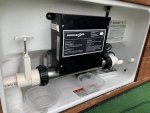Hi all,
First post here! Read a few posts and articles and people here seem pretty well-informed and I have an issue I need help with.
So I think I have a suction line leak on my 1995 Dimension 1 hot tub. It started a couple months ago. The leak is fairly slow—basically the floor gets wet, with the epicenter seeming to be at or very close to the corner where the filter is. I previously didn't know about suction line leaks and had used Fix-a-Leak several times (from what I've read here, a lot of users on TFP don't love it). I thought I was fixing the leak each time, b/c the floor would dry up after I used it, but in hindsight, I'm thinking the floor was just drying up b/c when I was applying fix-a-leak I was then running the tub for 10 hours—and suction line leaks are more apt to leak when the tub's NOT RUNNING, right? In addition, I noticed that when I put on a dirtier filter, bubbles came out of the jets, indicating to me that there's a small crack that draws MORE air in when a dirty filter limits the amount of water flow (thus adding more suction around the leak).
I'm currently running a test—going to run the tub while drying out the floor for a while, then stop drying the floor, keep it running, and see if it leaks. Then turn it off and see if the leak starts.
Assuming it ends up being a suction line leak, my questions are:
1. The bottle of Fix a Leak says you have to reverse flow if you want to use the product to fix such a leak—from what I've read at TFP, that's a "fairly complex procedure" which would essentially involve jury-rigging it somehow (e.g., removing the existing pump, running a different pump--basically creating my own reverse flow apparatus, right?
2. The preferred fix on TFP is basically to start tearing out insulation and looking for the leak, right?
3. I have a hope: I read somewhere that suction line leaks sometimes come from right where the filter seats—that I basically might be able to just remove and either re-lube or replace an o-ring down there or something, as that might be the culprit. Does that sound possible?
Thanks so much for any help you can provide. We really enjoy the hot tub and I'll be so happy once I get this leak resolved.
First post here! Read a few posts and articles and people here seem pretty well-informed and I have an issue I need help with.
So I think I have a suction line leak on my 1995 Dimension 1 hot tub. It started a couple months ago. The leak is fairly slow—basically the floor gets wet, with the epicenter seeming to be at or very close to the corner where the filter is. I previously didn't know about suction line leaks and had used Fix-a-Leak several times (from what I've read here, a lot of users on TFP don't love it). I thought I was fixing the leak each time, b/c the floor would dry up after I used it, but in hindsight, I'm thinking the floor was just drying up b/c when I was applying fix-a-leak I was then running the tub for 10 hours—and suction line leaks are more apt to leak when the tub's NOT RUNNING, right? In addition, I noticed that when I put on a dirtier filter, bubbles came out of the jets, indicating to me that there's a small crack that draws MORE air in when a dirty filter limits the amount of water flow (thus adding more suction around the leak).
I'm currently running a test—going to run the tub while drying out the floor for a while, then stop drying the floor, keep it running, and see if it leaks. Then turn it off and see if the leak starts.
Assuming it ends up being a suction line leak, my questions are:
1. The bottle of Fix a Leak says you have to reverse flow if you want to use the product to fix such a leak—from what I've read at TFP, that's a "fairly complex procedure" which would essentially involve jury-rigging it somehow (e.g., removing the existing pump, running a different pump--basically creating my own reverse flow apparatus, right?
2. The preferred fix on TFP is basically to start tearing out insulation and looking for the leak, right?
3. I have a hope: I read somewhere that suction line leaks sometimes come from right where the filter seats—that I basically might be able to just remove and either re-lube or replace an o-ring down there or something, as that might be the culprit. Does that sound possible?
Thanks so much for any help you can provide. We really enjoy the hot tub and I'll be so happy once I get this leak resolved.




